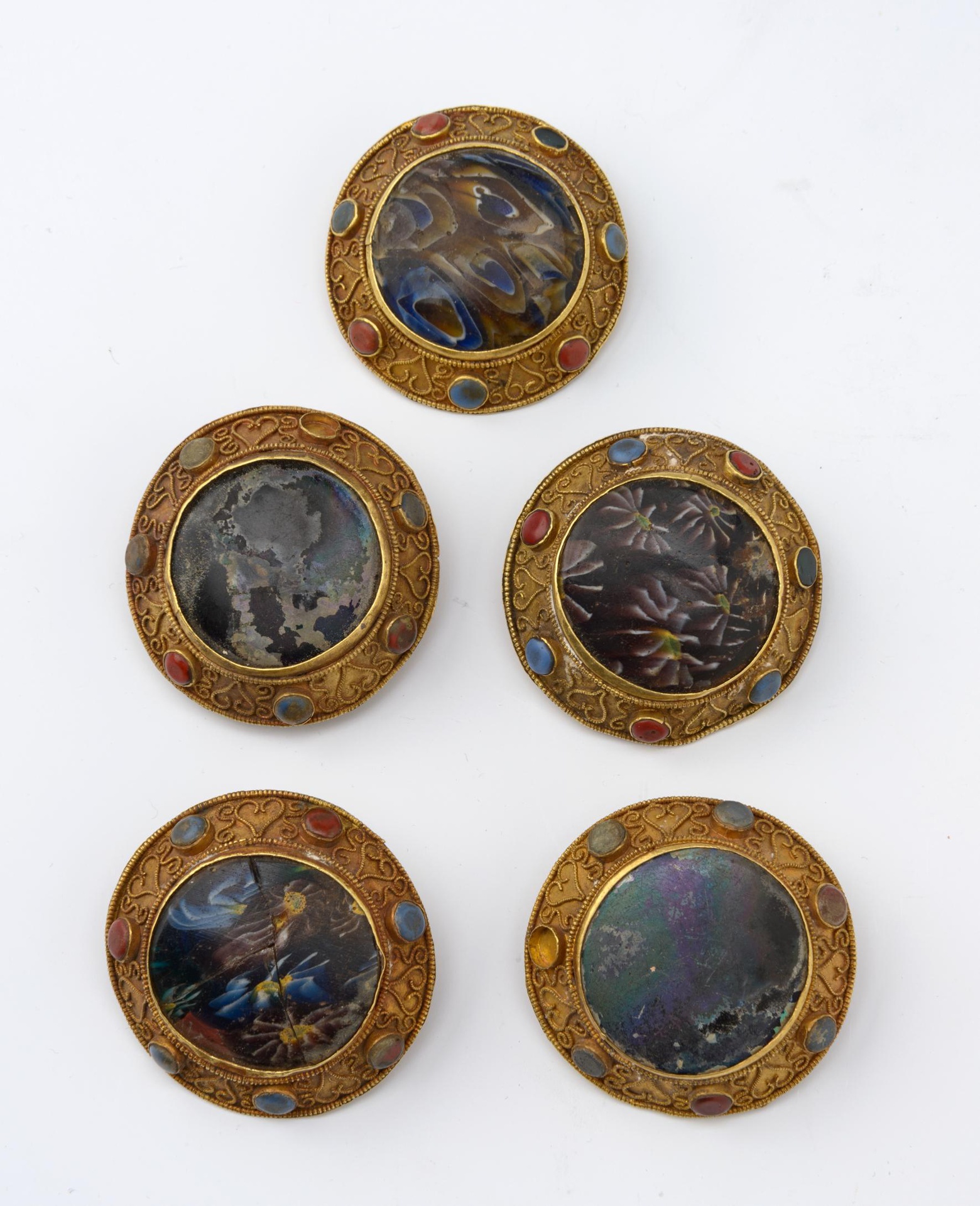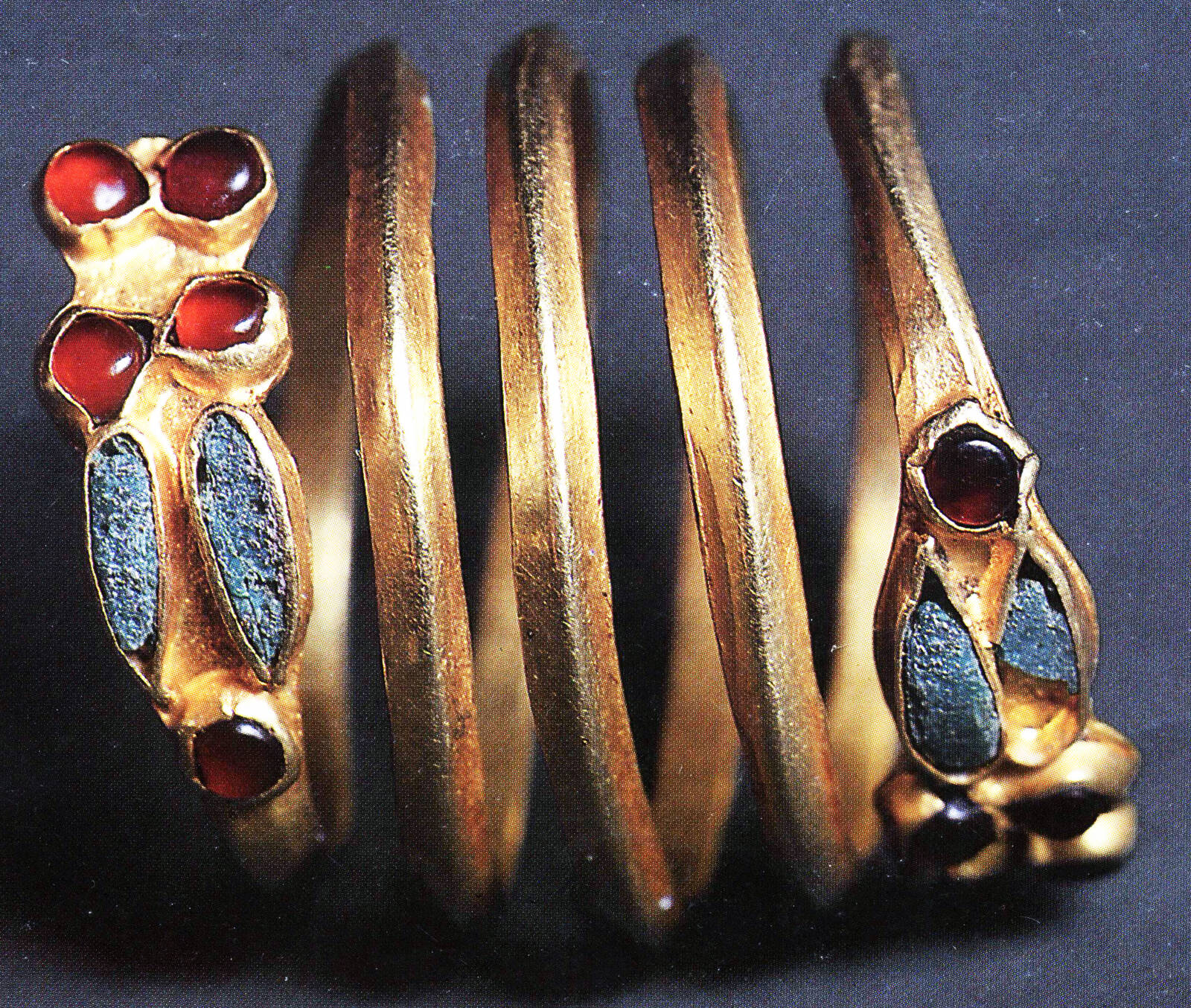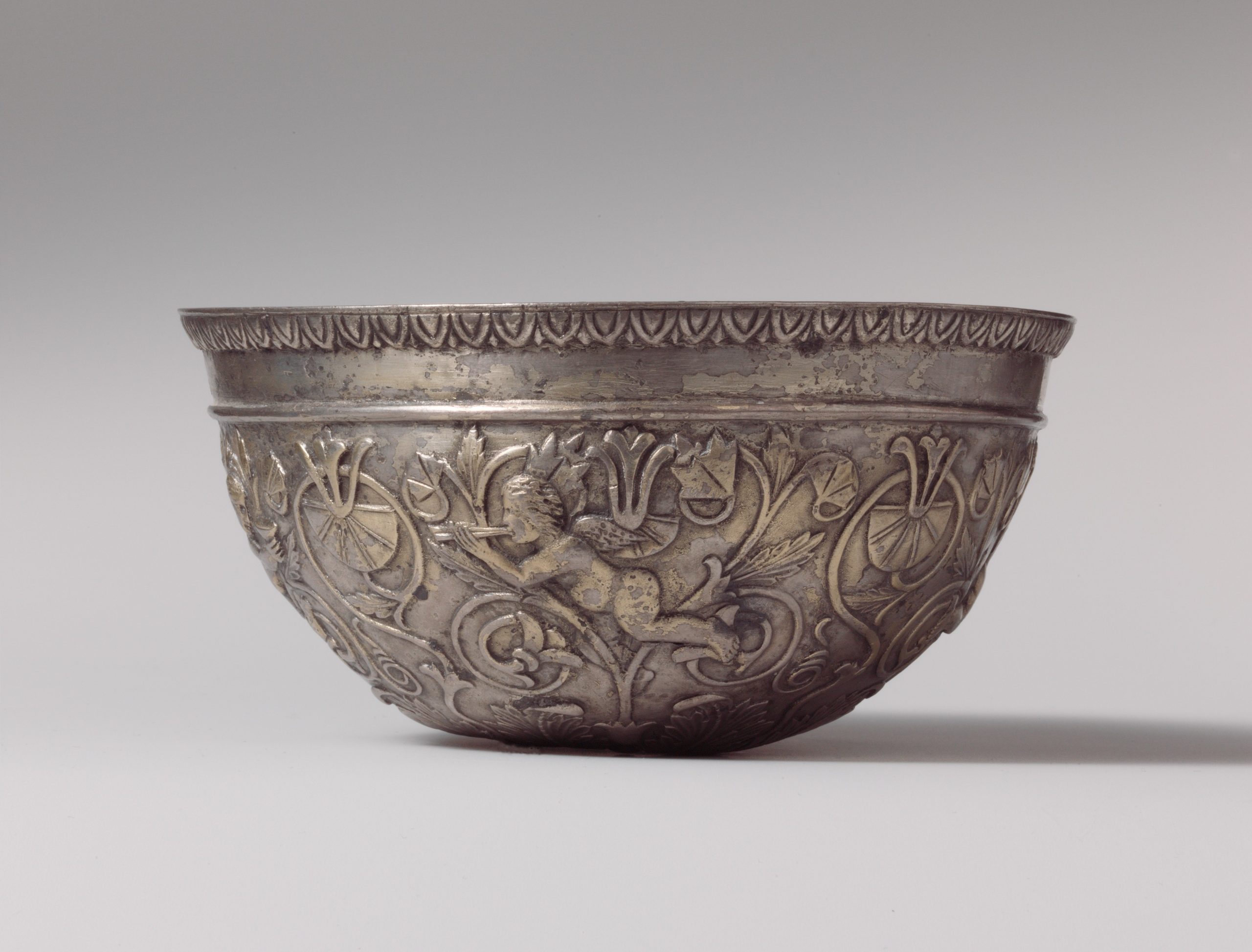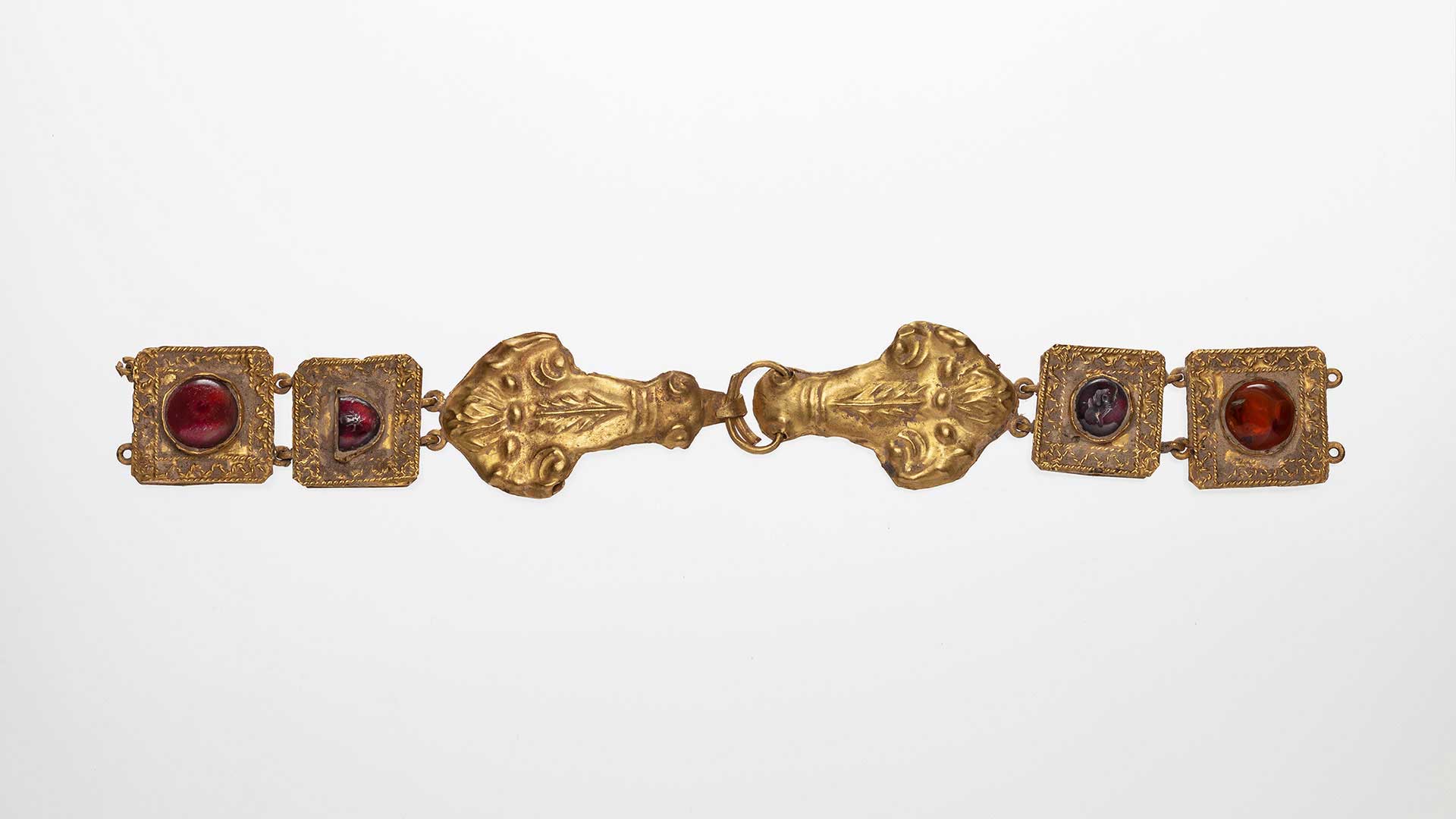Great Hungarian Plain, Pannonia
“Artifacts from the site called Tiszaföldvár-Téglagyár have been included in the János Damjanich Museum since the 1950s. Regular salvage excavations began at the site only in 1976, which lasted nearly 10 years. The archaeologists, ahead of the mine’s machines, tried to save as many finds as possible from senseless destruction. Among many other eras, Andrea H. Vaday excavated many Sarmatian tombs.
Unfortunately, one of the most special pieces was found only as a scattered find, probably from a vandalized, destroyed female grave. Perhaps the most valuable find of the cemetery is a gemmed shield, or according to other terminology, a pelta-shaped gold pendant, the surface of which is decorated with groups of spheres and granules. The Sarmatian goldsmith who made the pendant placed a jewel framed by a row of granules in the curved end of the shield. But the most interesting is the oval semi-precious stone inserted in the middle of the pendant, which is nothing more than a Roman gemma, i.e. a gemstone decorated with engravings. The gem shows a winged female figure who is the goddess of victory, Nike in Greek mythology and Victoria in Roman mythology.

Source:
An article “Treasures of the dawn of the Middle Ages“
THE BLOG OF THE ARCHAEOLOGICAL DEPARTMENT OF THE JÁNOS DAMJANICH MUSEUM, 2021
Golden pendants from Dănceni, Rep. Moldova
“The systematic investigations carried out in the 1970s in Dănceni (Republic of Moldova)led to the identification of an extensive Sântana de Mureș-Chernyakhov necropolis. Among the338 inhumation and incineration graves, two are of particular interest, as they revealed three lunulae made of gold. Two of them (one partially deteriorated), recovered from an incineration grave (no. 64), were manufactured in the filigree technique. They are almost identical in size (37 mm in length, 20 mm in width, 1 mm in thickness, and 4 mm diameter of the fastening hoops), suggesting their provenance from the same manufacturing centre and, likely, the same issue (Fig. 2/3–4). Te rich inventory of the tombs was conspicuous: two golden lunulae , two silver temple rings, yet another pendant (though made of bronze), an iron knife, a comb, and several beads. Notable is that the objects made of metal were not fired. The third golden pendant (Fig. 2/2) was likewise found in an incineration grave (no. 279), and measured 27 mm in length and 16 mm in width. Mention should be made of the fact that the cemetery from Dănceni also produced a golden “bucket” pendant (incineration tomb no. 79), and also a bronze lunula with three arms (or perhaps “twin”), discovered in the post-Chernyakhov layer (Fig. 2/5).The discussion concerning the chronology of the funerary complexes from Dănceni has led the investigator to assign the aforementioned tombs (nos. 64 and 279) to the last phase of the cemetery, datable to the last half of the 4th century. On the other hand, it has been argued some time ago that the crescentiform pendants and those of the “bucket” type, decorated with filigrees and granulations, with insertions of precious or semiprecious stones, amber, coloured glass and paste, and associated with the
Monstruösefibeln and trapezoid combs with three plates, were part of the typical inventory of the auxiliary troops of the period following the collapse of the Gallic Empire. In line with the naturally advancement of research, two recent studies have argued that the crescentiform pendants of 3rd–4th century Europe were based on provincial Roman models of the 1st–2nd century. They were classified into three main types: (1) Crescentiform pendants decorated with filigree and granulation, specific to the “horizon of princely tombs” from Central Germany (Leuna – Hassleben), belonging to the C2
phase (second half of the 3rd century); (2) Simple lunulae, which have a smooth, unornamented body, dated to the C3
–D phases (4th century); (3) Crescentiform pendants produced by pressing, with filigree and impressions, from the D2–E phases (end of the 4th century–5th century).” [Virgil Mihailescu-Birliba]
Virgil Mihailescu-Birliba
TWO GOLDEN PENDANTS FROM THE 4 TH CENTURY
https://www.academia.edu

After Virgil Mihailescu-Birliba

III-IV вв. н. э., черняховская культура. Готское государство в Молдове (II-IV вв. н. э.). Готы
1. Село Данчены, Яловенский район. Раскопки Рафаловича И. А., 1976 год. Длина 27 мм. Высота 16 мм. 2. Село Данчены, Яловенский район. Раскопки Рафаловича И. А., 1975 год. Реконструкция.
3. Село Грушевица, Черновицкая область, Украина. Клад. Случайная находка. Длина 30 мм. Высота 15 мм.
_______________________________
1. The Village of Danceni. Excavation 1976. Gold and glass paste; 16 / 27 mm
2. The Village of Danceni. Excavation 1975.
3. The Village of Grusevita, The Chernovtsy province, Ukraine.
Source: Евгений Паскарь https://historymoldavia.blogspot.com/2016/01/blog-post.html
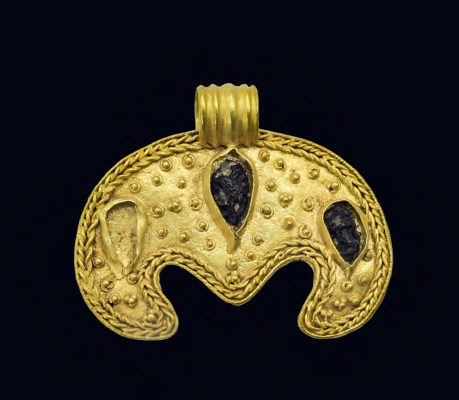
From Danceni, Ialoveni district. Cemetery, burial 279.
The pendant is pelt-shaped, crescent-shaped, with a triangular protruding central part. The general outline of the pendant is emphasized by a filigree line. The field is decorated with grains in the form of pyramids and individual balls. On the front side, in the center and along the edges, three sockets are soldered, two of them retain paste inserts.
A corrugated eyelet extends from the middle of the top edge of the pendant for hanging. Gold 750‰. Weight 3.22 g.
Length 27 mm. Width 16 mm. The diameter of the ear is 3 mm.
Second half of the 3rd – beginning of the 5th century.
- Ana Niculiţă, Piese de giuvaiergerie antică din colecţiile Muzeului Naţional de Istorie a Moldovei (Catalog) Seria „Albume” III, Chişinău, 2018. 296 p


